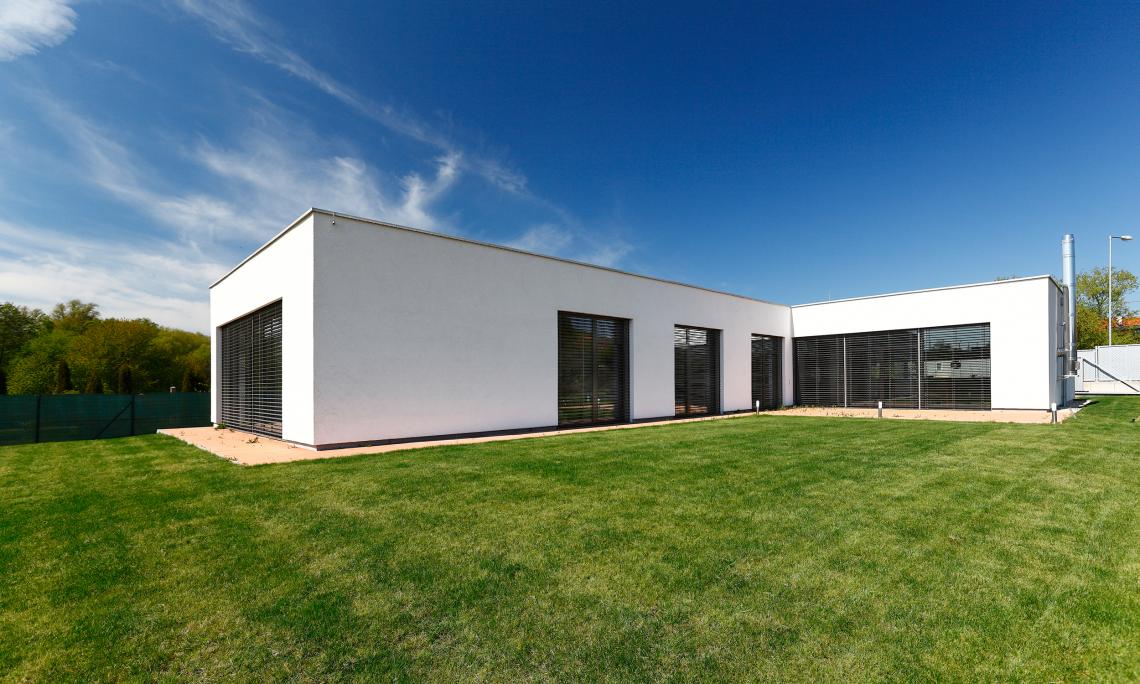
One-storey single-family house is economical due to the compact design and properly facing windows. Comfort of the residents is secured by advanced technologies - heat pump with cooling, heat recovery ventilation and smart wiring.
Construction of the low-energy detached bungalow
Regarding large spans without supporting columns in the interior we designed the ceiling on the first floor from reinforced concrete. The thickness of the ceiling is 250mm and the weigth is 3000kg. To maintan a visual effect of the concrete ceiling we used the very new boards. The results is a perfect concrete ceiling. For lighting we chose lamps on the walls or standing lamps, so that the compact concrete ceiling is still a dominant feature. There is no plaster on the ceiling where wiring could be hidden, therefore this had to be planned before realization of the ceiling.
Starting of the construction - a foundation of concrete shuttering blocks
Just after removal of top soil we found out that because of the underground water it was necessary to start building the foundations deeper. For this purpose we used concrete shuttering blocks.
Concrete slab
Wood-aluminium windows is the best solution which is currently available. The windows are air-proof because they are sealed up with tapes.
Masonry of the Ytong walls
The material used for the walls is Ytong with the thickness of 300mm. An adventage of Ytong in comparison with bricks is its compactness. It does not have any holes or gaps inside, on the other hand, bricks have pores and if they are not used properly air-proofness of the house can be damaged. Ytong is a very good for insulation, especially in low-energy houses, where material used for cladding the house has to be the best for insulation.
Concreting the concrete ceiling
Regarding large-scale spans without supporting columns in the interior we designed the ceiling on the first floor from reinforced concrete. The thickness of the ceiling is 250mm and the weigth is 3000kg. To maintan a visual effect of the concrete ceiling we used the very new boards. The results is a perfect concrete ceiling. For lighting we chose lamps on the walls or standing lamps, so that the compact concrete ceiling is still a dominant feature. There is no plaster on the ceiling where wiring could be hidden, therefore this had to be planned before realization of the ceiling.
Preparing to build the concrete ceiling
Installation of wood-aluminium windows
Wood-aluminium windows is the best solution which is currently available. The windows are air-proof because they are sealed up with tapes. The windows are hung on corbels.
Installation of wood-aluminium windows
The house is fully equipped with modern technologies, which are money saving and comfortable. For heating we used a heat pump by Daikin Atherma, which both heats and cools. The heat pump provides hot water, which goes into the water pipes and into the underfloor heating. The pump can "blow" hot or cold air into rooms via fancoil. Fresh air is let in and forced out via sanitary rooms. Geberit Duofix is a system for ventilation through on toilets which we used. It is installed on the toilet seat.
Boxes for blinds under the plaster
Finished construction of the fabric without interior
We used polystyrene ( 26cm thick) for an insulation of the outer shell of the house - external walls
Digging of the well
We consider underfloor heating to be the best option for low-energy houses. It is a low-heat source based on small differencies between temperature of air and floor, so that dust does not fly around the room which usally happens with high-heat sources. When high-quality windows are used, there is no need to use floor convectors. The only high-heat sources used in this house are heated towel rail radiators.
Installation of air conditioning
The house is fully equipped with modern technologies, which are money saving and comfortable. For heating we used a heat pump by Daikin Atherma, which both heats and cools. The heat pump provides hot water, which goes into the water pipes and into the underfloor heating. The pump can "blow" hot or cold air into rooms via fancoil. Fresh air is let in and forced out via sanitary rooms. Geberit Duofix is a system for ventilation through on toilets which we used. It is installed on the toilet seat.
Air conditioning circuits
Geberit flushing system with odor extraction under the plaster
Extra thermal insulation of polystyrene
For an external insulation of the house - external walls we used polystyrene (26cm thick).
Extra thermal insulation of the cladding
More insulation on doors and terrace
Installation of heating - underfloor heating by Rehau
We consider underfloor heating to be the best option for low-energy houses. It is a low-heat source based on small differencies between temperature of air and floor, so that dust does not fly around the room which usally happens with high-heat sources. When high-quality windows are used, there is no need to use floor convectors. The only high-heat sources used in this house are heated towel rail radiators.
System of the underfloor heating
We used intelligent wiring in the house with bus-system Legrand Bticino. We always think about wiring before building any facility, so that later there is no need for additing electrical extension leads because all the speakers, computers, television sets, lamps, switches and other electrical suppliences are planned in advance.
Installation of the underfloor heating
Construction of the fireplace with external air induction
Installation of the fireplace
Plastering of the walls
Wiring
We used bus-system Legrand Bticino- intelligent wiring in the houseWe always think about wiring before building any facility, so that later there is no need for additing electrical extension leads because all the speakers, computers, television sets, lamps, switches and other electrical suppliences are planned in advance.
Checking of the wiring
The original visualizations of the low-energy bungalow look almost the same as the photos taken of the actual built house. The only changes we made were: shortening of the terrace, changing wood on the terrace for concrete shuttering blocks and that there is no exterior swimming pool.
Installation of furniture and carpentry
Installation of furniture
The layout of the house is neat and well-arranged which will make the house comfortable for living. The layout is divided into entrances, which are optically linked with the day zone. The night zone includes guest rooms, playrooms and master bedroom.
The house is divided into the day and night zone. The day zone includes an entrace hall, storage, which can be accessed via the exterior and living room with kitchen. The day zone is orientated to the terrace - south-west. The night zone includes 4 rooms and the master bedroom accessed via the night corridor. The house includes 3 toilets and bathrooms, one bathroom and toilet can be directly accessed via the master bedroom. The terrace in the garden can be accessed via the four rooms directly. The storage spaces in the night zone include a closet with a washing machine and built-in wardrobes in the bedrooms.
The external walls are insulated with Ytong (300mm) and EPS (250mm). Most of the partition walls in the interior are made of bricks, where there is a lot of wiring those walls are made of gypsumcard. The floor is made of a reinforced concrete board (200mm) with insulation (350mm), the roof is made of reinforced concrete a board (250mm) and insulation (500mm).


